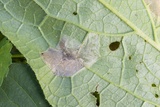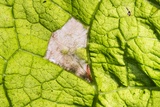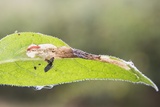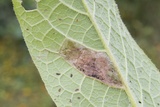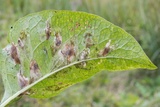Dialectica imperialella (Zeller, 1847) Species
Last modified: Dec. 10, 2025, 1:20 p.m.
A rare species in Belgium, at first only known from a publication in 1860 from NA. The second observation was done in 2008 in AN. Since then, the species is recorded from other provinces, but always in very small numbers, except in some rare occasions. But it is still underrecorded, because the species seems not to be rare in the Netherlands.
Details
- Classification
- Family: Gracillariidae > Subfamily: Acrocercopinae > Genus: Dialectica > Species: Dialectica imperialella
- Vernacular names
- Smeerwortelsteltmot (NL), Fen slender (EN), Silberfleck-Beinwellfalter (DE)
- First mention in Belgium
- De Fré Ch. 1860. Lépidoptères nouvellement découverts en Belgique. — Annales de la Société entomologique belge 4: 113–115. On page 109. view page
- Status
-
Native
Distribution
Imago
The imago has a dark brown ground colour with pure white markings. It sits with its front part upturned at an angle of 45°.
Museum specimens
No pictures yet!Specimens in nature
No pictures yet!Caterpillar
The first instars are light green, but later on the larva becomes rosy to brownish red.
Mine
The mine starts as a small, spiral on the underside of the leaf but turns into a blotch mine which most of the time includes the initial spiral. The last instars also eat the palisade tissue so that the mine becomes visible from the upper side of the leaf in the form of some brownish dots.
See also gracillariidae.net, and bladmineerders.be.
Cocoon/pupa
A flat, reddish cocoon.
Bionomics
Like most of the species in the subfamily Acrocercopinae, the full-grown larva exits the mine, drops to the ground and pupates there between leaf litter. It first spins a flat, reddish cocoon. In some rare cases, the caterpillar constructs its cocoon on the leaf without descending to the leaf litter.
Flight periods
One generation a year in May and June.
Observed on
- Host plant (species):
- Symphytum officinale, Pulmonaria officinalis and Lithospermum officinale
The larva mines in the leaves of Lithospernum officinale, Pulmonaria officinalis and Symphytum officinale.
